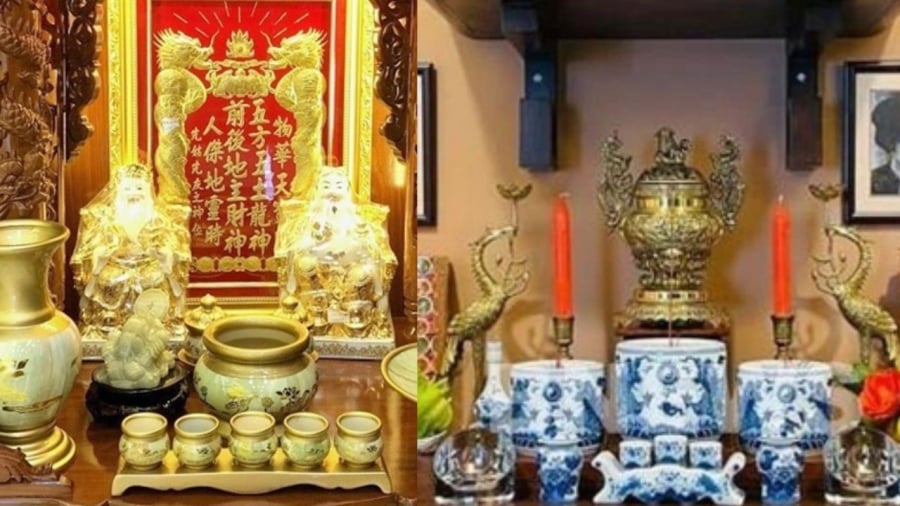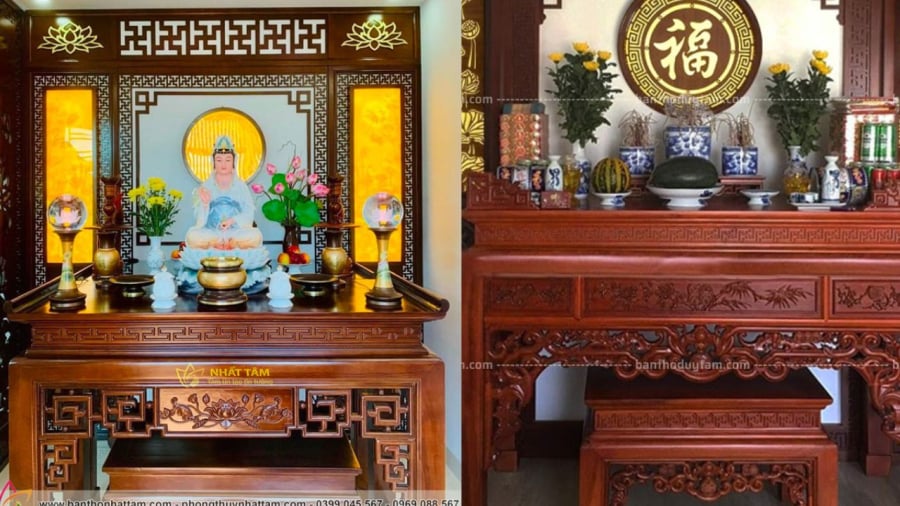Water is the source of life, and as such, it is an essential offering when praying to deities and ancestors. While flowers and fruits may be omitted on certain occasions, water is a must, especially in Vietnamese culture, where a glass of water often initiates a conversation.
Water is a vital offering during every prayer session. Depending on the family’s preference and tradition, they may use a water set or a simple glass for this purpose. Families who purchase a matching altar set often opt for a water set, which includes a water pitcher and cups specifically designed for religious purposes. Alternatively, families with a more straightforward approach may use regular glasses to hold the water. Typically, one, three, or five glasses of water are used, so water sets usually come in sets of three or five cups to accommodate these needs. Families can then choose the set that best fits the size of their altar.

Water is an essential offering on altars.
Where should the water be placed on the altar?
When using a water set or glasses, the placement on the ancestor and deity altars is typically in front of the incense burner and fruit plate. The water set is usually positioned centrally on the altar, neither left nor right. If there are three incense burners, the water set should be placed in front of the middle one. On a Buddhist altar, the placement of the water set is more flexible and can be placed on either the left or right side. Additionally, Buddhist altars often feature glass cups filled with water, symbolizing a mirror for self-reflection and improvement for Buddhists.

The water set is typically placed in the center, in front of the incense burner and fruit plate.
In the case of using a set of jars for water, rice, and salt, this set is usually placed on the ancestor and deity altars, in front of the incense burner but behind the fruit plate. This set differs from the water set or glasses and is typically prepared at the beginning of the year and left untouched for the entire year, with refills added as needed. In contrast, the water set or glasses are replaced after each prayer session. In the set of jars, the water jar is placed in the center, with the salt and rice jars on either side, forming a horizontal row in front of the incense burner but behind the fruit plate.
If additional water bottles are used, they are placed behind the fruit plate but in front of and on either side of the incense burner. This placement not only adheres to aesthetic considerations but also aligns with the principles of worshipping feng shui, representing a balance on the altar and symbolizing the harmony of the five elements, as well as the family’s aspirations for wealth, prosperity, and good fortune.
This information is based on traditional beliefs and practices and may vary depending on regional customs and personal interpretations.
“Grow Green Onions with These Two Easy Methods for a Year-Round Supply”
Growing green onions is a simple and easy task, and you can easily do it at home. All you need are some onion roots, and you can grow them in water (hydroponically) or in soil, using plastic bottles. This way, you not only get to enjoy fresh, clean greens but also have a beautiful, edible decoration in your home.
The Kitchen Dictates the Prosperity of the Home: 4 Golden Feng Shui Principles for Abundant Wealth and Fortune
The four golden rules of Feng Shui in the kitchen are essential to creating a harmonious and healthy living space that attracts wealth and prosperity. By following these principles, you can design a kitchen that not only looks and feels balanced but also brings positive energy and abundance into your life. Discover the secrets to a harmonious kitchen and unlock the potential for a prosperous future.
The Secret to a Prosperous Home: Unlocking the Four Key Indicators of Wealth
In the realm of feng shui, there are four essential items that can bring good fortune to homeowners. These items are believed to be lucky charms that can attract positive energy and prosperity. By incorporating these elements into your home, you can create a harmonious and fortunate living space. So, what are these four lucky charms, and why are they so important in feng shui?
“Don’t Let These Flower Vases Take Away Your Luck: A Guide to Avoiding Common Home Decor Mistakes”
Introducing the world of floral offerings with a twist – a guide to navigating the dos and don’ts of flower arrangements for ceremonial purposes. Uncover the hidden meanings behind these vibrant blooms and avoid potential pitfalls with a simple yet transformative twist. Prepare to immerse yourself in a journey of cultural significance and aesthetic appeal, where every petal unfolds a story and each arrangement speaks volumes.






































